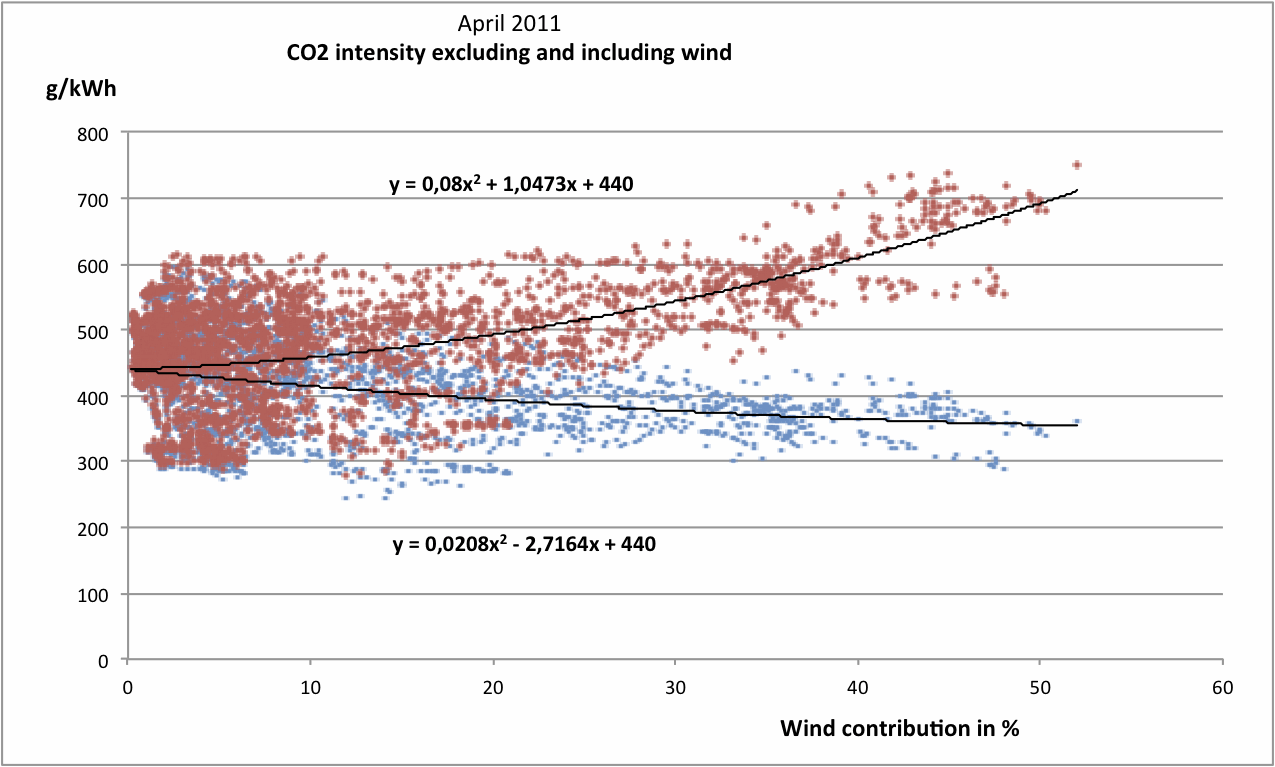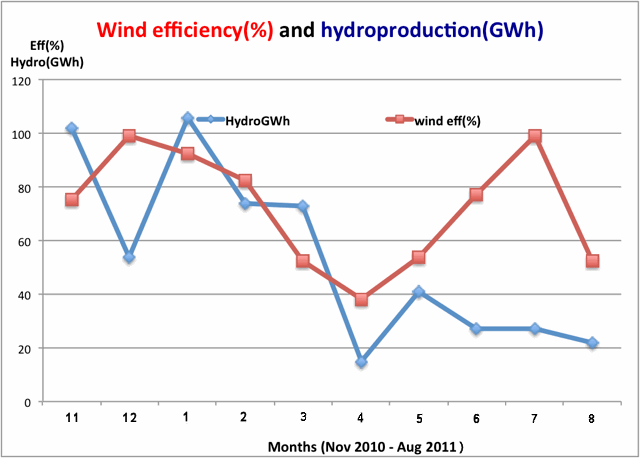
Wind energy and CO2 emissions - 2.
Fred Udo
Introduction.
The purpose of adding wind energy to an electric grid is to reduce the fuel consumption of the fossil
based generators of the system. Wind energy proponents repeat incessantly, that adding x% of wind
energy reduces x% fuel or CO2 emission.
In many countries this unsubstantiated statement cannot be verified, because real-time grid operation
data is witheld from the public.
Recently Eirgrid, the Irish grid operator, began to publish real time data about the performance
of the Irish electricity grid. The Eirgrid website
shows the values of the total demand, the production of wind and the CO2
emission for each quarter of an hour.
This data enabled a study of the impact of wind energy on the Irish electric grid.
The first results are published in:
Wind energy in the Irish power system.This article contains a second analysis of the relation
between CO2 emission and the contribution of wind energy using the
real time operations data from Eirgrid.
The conclusion is, that the reduction of fossil fuel consumption is bound within tight limits.
Definitions.
In discussions about this subject wind penetration is defined as the contribution of wind energy
to the total electricity production in a year.
As the Irish data are available for each quarter of an hour, this period of sampling time can be
chosen much shorter. In that case one has to distinguish between wind contribution and wind penetration.
The two numbers are only equivalent if the integration is done over a time span, which allows the
(Weibull) distribution of wind velocities to be represented in the data.
(The numbers are not equivalent, if we evaluate the wind contribution on a windy day).
The efficiency of adding wind to an electric grid is defined as the reduction of
CO2 intensity divided by the contribution of wind to the system.
Promotors of wind energy put this efficiency invariably at 100%.
The CO2 intensity is the amount of
CO2 emitted for the production of one kWh of electricity.
This quantity can be defined as the emission of the fossile fired plants only or as the emission
of the system including wind. Both quantities will be used here.
The Irish system
The fuel mix of the Irish grid is illustrated in the figure 1 of the first publication.
The share of gas (66%) and solid fuel (21%) is about the same as in the Dutch system.
The wind penetration was 9,8% in 2010.
The study is hampered by the fact that the contribution of hydro energy is not specified in
the Eirgrid data, although the Irish system has of 216 MW of hydropower and one 280 MW pumped
storage hydro plant. Hydro energy can be quickly ramped up and down and is therefore the ideal
backup for accommodating the variable wind energy to the grid.
April 2011.
During the month of April 2011 the contribution from hydro was small due to minimal rainfall,
while the pumped hydro facility was undergoing a renovation. In April we see the response of a
system with 21% coal and peat and 66% gas subjected to 12% wind energy.
The correlation between wind contribution expressed in % of the total demand and the
CO2emission of the conventional plants for every one of the
2880 datapoints was studied. The CO2 emission is best expressed
as CO2 intensity. This is the CO2
emission in grams per kilowatthour produced by the totality of conventional fossil fuel fired power
stations on the grid.
The CO2 intensity can also be calculated as the
CO2 emission divided by the total electricity production.
The diagram below (fig. 1) shows the correlation of both CO2
intensities as a function of the contribution of wind to the system.

The red data points represent the CO2 intensities from conventional
generators. The blue points represent the CO2 intensities
calculated over the production including the wind contribution. A quadratic fit curve has been
calculated for each of the two populations. These fits have been adjusted so that they cross the
zero wind contribution line with the same value of CO2 intensity.
This fixes the CO2 intensity at zero wind at 440 g/kWh. This
result is slightly different from the number given in the original article (436 g/kWh), because we
now use two quadratic fits instead of one linear fit. The average of the blue points gives the
overall CO2 intensity as 418 g/kWh, so the
CO2 reduction is 22/440 = 5,0%.
The wind penetration was 12% in this month.
The red emissions increase and the blue points run more horizontal with increasing wind contribution.
This implies, that wind contributions above 30% have little influence on the
CO2 emission. The last chapter discusses the consequences.
Please note:
The points presented in the correlation diagram are based on the emission data calculated
by Eirgrid, which do not include heat degradation effects of ramping the conventional generators.
This effect causes extra fuel consumption and thus increases the CO2 emission.
There are good reasons for applying such a correction.
The CO2 intensity of the Irish grid was 533g/kWh in 2009. This
number results from a fuel input – electricity output analysis.
Integration of the tables of Eirgrid for the period November 2010 till August 2011 results in a
value for the CO2 emission of 450 g/kWh.
The difference between the two numbers cannot be explained by a sudden drop of 20% in
CO2 intensity for the whole Irish grid in the timespan of
one year, so an extra source of CO2 is needed. Cycling is the obvious candidate.
Le Pair has suggested an algoritm to account
for the cycling of fuel generators. Applying an algorithm on the data as suggested by Le Pair increases
the total CO2 emission by 5%. This is due to the daily variations of
the demand together with the variations of wind.
The CO2 reduction due to the 12% windpenetration decreases from
5,0 to 4,0% as a result of this increase due to cycling.
This implies, that the measured CO2 reduction is 4,0/12 = 33% of
the value quoted by wind energy promotors. Please also note that this holds for 12% wind penetration
in a system that has still a small component of hydro energy.
The period from November 2010 to August 2011.
Other months have a substantially larger component of hydro energy, so the performance of the system
in terms of CO2 emission improves accordingly.
The following plot (fig. 2) shows the efficiency in the period from November
2010 to August 2011 together with the hydro-power production in the same months.
The data was obtained by applying the same analysis to the data of all the other months available.

The response of the Irish system over the period Nov 2010 to August 2011 to a wind penetration of
10% is an overall reduction of CO2 intensity with 7%. This reduction
decreases to 5,6%, if an algorithm based on the effect of cycling is taken into account. The efficiency
of wind is 56% in the Irish system at 10% wind penetration.
The conclusion drawn from the April data is, that a system with 21% coal and 65% gas and a small
amount of hydropower will show a CO2 intensity reduction of about
4% for absorbing 10% wind energy; i.e. a 40% efficiency of wind energy.
Curtailment.
The correlation diagram shows, that a wind energy penetration of 12% implies a variation of wind
contributions between zero and 50% of the total demand. The distribution of the points makes, that
the bottom curve is flattening out. The conclusion is, that percentages of wind above 30% cause
little or no reduction in CO2 emission due to decreased fuel
efficiency of the backup stations.
The fit to the blue points shows the overall CO2 intensity
to drop from 377 g/kWh to 356 g/kWh, if the windcontribution increases from 30% to 50%.
The average CO2 intensity (all the blue points) is 417,9 g/kWh.
Curtailment at 30% wind is applied by attributing all points above 30% the fitted value at 30%
wind contribution (377 g/kWh).
The average CO2 intensity increases from 417,9 g/kWh to 418,9 g/kWh in this case.
This is an increase of 0,24%. The curtailment causes 7,2% of the wind energy to be lost .
The wind contribution lowers from 12% to 12%*(1 - 0,072) = 11%.
Variation of the upper limit for the wind contribution gives the following results:
| Curtailment at % wind |
CO2 int. [g/kWh] |
CO2 int. increase |
wind unused |
|---|---|---|---|
| none <30% <25% <20% |
417,9 418,9 419,8 421,5 |
0 0,24% 0,45% 0,86% |
0% 7,2% 13,0% 21,0% |
The first conclusion is, that curtailment at twice the penetration value is a perfectly sensible
operation. It significantly reduces maintenance in the conventional stations and reduces the extra
fuel consumption due to the deep up and down ramping to accommodate the excess wind energy to the grid.
The curtailment limit of 25% is not a fixed limit as it is related to the instantaneous demand. This
demand has the usual day – night fluctuation, so the system can accommodate more wind energy during the day.
The second conclusion is, that increasing the penetration of wind energy beyond 10% will have a
negligible effect on the fuel consumption of the total system.
These conclusions hold only for a system without energy storage.
Monnickendam, October 21, 2011
Updated (fig.2) May 4th, 2012.
E-mail: Fred Udo